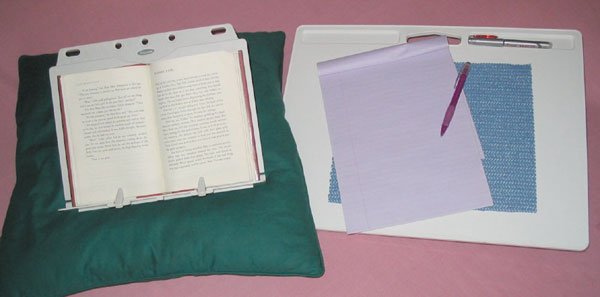Although the ergonomist in me cringes at the thought, I admit to
being one of those people who likes to sit in bed and write. I have
kindred partners in ergonomic crime who choose to sit in bed to
read, and others who work on their laptops or sit up and watch
TV.
Although the ergonomist in me cringes at the thought, I admit to being one of those people who likes to sit in bed and write. I have kindred partners in ergonomic crime who choose to sit in bed to read, and others who work on their laptops or sit up and watch TV.
There’s something about the comfy mattress under us, the blankets over the legs, the down-filled pillows and soft lighting that makes it oh-so-cozy.
So, though I should be saying, “DON’T DO IT!” instead I’m going to repeat the words I once gave my teenage children: “If you’re going to do it, at least learn how to be safe.”
Here’s how to sit in your bed with the least physical agony:
Make it like a chair.
Beds are not designed for sitting. Chairs are for sitting. So the first thing to do is to make the bed as much like a chair as you can.
Create a sitting surface that’s higher than your feet. This can make it easier to maintain some semblance of the normal arch in your low back. Sit on top of a pillow, or better yet, a sofa cushion.
Provide good support for your back. Use a cushion made for this purpose, or one or two large pillows. Try to stuff some of the cushioning firmly against your low back. A stable headboard or wall is essential as a foundation to the pillows and cushions.
Put a bend in your legs. This keeps you from hyperextending the knee joints and further helps your spinal positioning. Place a pillow under your legs, just above the knees. Avoid prolonged pressure directly behind the knees because of circulation concerns. You may sit cross-legged for short periods if this is comfortable for you.
Take care of the rest of you.
Now that you’ve given yourself more chair-like support, pay attention to your neck and arms. If your book, paper or laptop is sitting directly on your lap, you’re bending your neck down at an awkward angle to see it. Use a pillow on your lap to raise the item a bit closer to eye level, and angle it toward your face. Add an adjustable “book holder” if you wish to angle and support your reading material even more. If you want to hold your book up with your hands, use pillows to support your arms and lessen the tension of sustained holding. For writing, you might like a “lap desk” with its bean-bag bottom and firm writing surface. You may still need a pillow under the lap desk to raise and angle it properly.
Stay there only briefly.
As with any stationary activity, be sure to limit the time you spend sitting in bed and change positions frequently.
Now despite my willingness to advise, I cannot in good conscience advocate sitting in bed as a truly acceptable practice. So I ask you to please consider these ergonomically preferred alternatives:
Sit at your dining or kitchen table in a comfortable chair (with a blanket if you desire). Hold your reading material in place “hands-free” using a document or book holder. Or try using a binder with the thick side away from you, to angle the material toward you. Add a piece of non-skid shelf lining material to prevent sliding. Another choice is to place a pillow on the table to support your hands while you hold your book.
Sit on a comfortably upholstered chair or sofa while you use the laptop or write on a lap desk. Use extra pillows behind you to provide back support if needed. Place a pillow or cushion under the computer or lap desk to ease neck strain while you look at your work.
Beds aren’t made for sitting while reading, writing, watching TV or using the laptop. But if the coziness of the bed is irresistible, at least position and support yourself with care using the tips I’ve given you.













